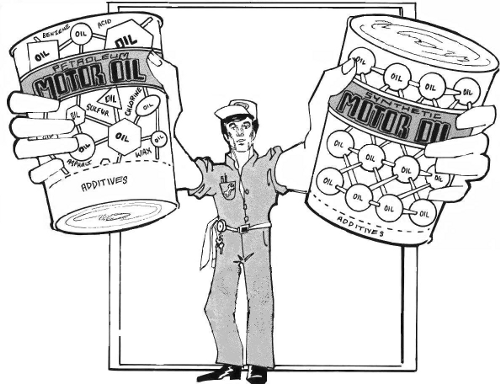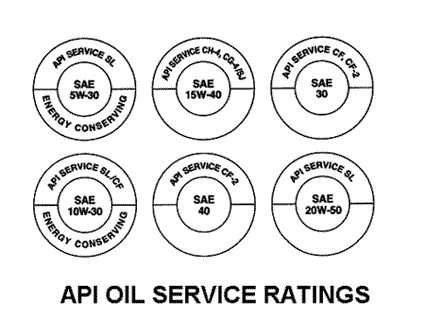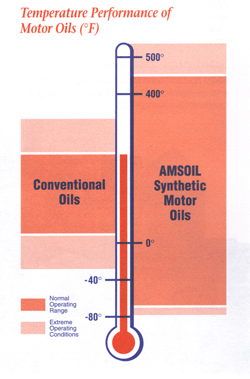The various chemicals that comprise the oil additives in the finished motor oil function to provide:
- Anti wear
- Anti foam
- Corrosion protection
- Acid neutralization
- Maintenance of viscosity
- Detergency
- Dispersant
These are the chemicals that help modern motor oils meet the increasing demands of today’s high-tech engines. Their quality varies widely throughout the lubrication industry, ranging from a bare minimum in some oils (to comply with certain requirements) to exceptionally high quality, as in all AMSOIL motor oils and the complete product line of synthetic lubricants.
Lubricant Base Stock
The base stock makes up the bulk of the oil’s volume. The base stock of a motor oil lubricates internal moving parts, removes heat and seals piston rings and can be made from:
- Petroleum
- Chemically synthesized materials
- Combination of synthetics and petroleum (called para-synthetic, semi-synthetic or synthetic blend.)
A petroleum base stock consists of many different oil fractions that form the final product. Generally, molecules of a petroleum base stock are long carbon chains that can be sensitive to the stress of heat and “boil off” at relatively low temperatures. Engine temperatures break down these molecular chains, changing the physical properties (such as viscosity) of the motor oil.
The difference with synthetic base stocks is that molecules are uniformly shaped, which makes them more resistant to the stress of heat. Because AMSOIL synthetic motor oils possess these uniformly-shaped molecules they have a low “boil off” rate thus, their physical properties (such as viscosity) do not change.

What Motor Oil Must Do
Modern motor oil is a highly specialized product carefully developed by engineers and chemists to perform many essential functions. A motor oil must:
- Permit easy starting
- Lubricate engine parts and prevent wear
- Reduce friction Protect against rust and corrosion
- Keep engine parts clean
- Minimize combustion chamber deposits
- Cool engine parts
- Seal combustion pressures
- Be non-foaming
- Aid fuel economy
Improvements in Oil
The quality of motor oil has changed dramatically in the past 30 years, and new demands on lubricants in modern engine design call for oils that meet stringent requirements. Variations in oil’s ability to meet the requirements determine which service classification rating and viscosity grade it receives.

Service classifications are determined by the American Petroleum Institute. Viscosity grades of oils are determined by the Society of Automotive Engineers. These two organizations have set industry standards for motor oils for more than 75 years.
Viscosity
Viscosity, the most important property of oil, refers to the oil’s resistance to flow. The viscosity of oil varies with changes in temperature – thinner when hot, thicker when cold. Oil must be able to flow at cold temperatures to lubricate internal moving parts upon starting the engine. It must also remain viscous or “thick” enough to protect an engine at high operating temperatures. When oil is used at a variety of temperatures, a typical engine operating environment, the change of viscosity must remain as small as possible with temperature variation.
The measure of oil’s viscosity change is called the Viscosity Index number (VI), the higher the number, the smaller the viscosity change which means the better the oil protects the engine. The number does not indicate the actual viscosity in high and low temperature extremes of the oil, instead it represents the rate of viscosity change with temperature change. Viscosity improvers are viscous chemical compounds called polymers or polymeric compounds that decrease the rate at which oils change viscosity with temperature. These viscosity modifiers extend motor oil’s operating temperature range and make multi-grade or all season oils possible. However, low quality viscosity improvers lend themselves to shearing.
The VI is measured by comparing the viscosity of the oil at 40°C (104°F) with its viscosity at 100°C (212°F). VI can provide insight into oil’s ability to perform at high and low temperatures. Petroleum-based motor oils require the use of viscosity improvers to meet the low-temperature requirements of SAE 0W, 5W or 10W and the high-temperature requirements of SAE 30 or heavier oil. Synthetic-based motor oils have inherent or have a naturally-high viscosity index and require less viscosity improver additive than petroleum oils; however, this inherent quality will vary among synthetic manufactures.

Note: store pure maple syrup in the freezer and see what happens,… this is an example of an organic base that inherently remains fluid in cold temperatures.
Cold-Temperature Protection
Motor oil must begin to circulate as soon as the engine is started. If oil gets cold enough and begins to solidify, it fails to flow through the oil screen to the pump at engine start and causes bearings and other critical parts to fail almost immediately.
Pour point is an indicator of the ability of oil to flow at cold operating temperatures. It is the lowest temperature at which the fluid will flow. Modern refining techniques remove most of the wax from petroleum oil, but some wax-like molecules remain. These wax-like molecules are soluble at ambient temperatures above freezing, but crystallize into a honeycomb-like structure at lower temperatures and cause oil circulation problems.
Pour point depressants keep wax crystals in the oil microscopically small and prevent them from joining together to form the honeycomb-like structure. They lower the temperature at which oil will pour or flow and are found in most motor oils designed for cold-weather use. As synthetic motor oils do not contain those wax crystals, they do not require pour point depressant additives.
Wear Protection
Since one of oil’s main functions is to prevent friction and wear, anti-wear additives are part of the chemical composition of oil. These additives protect engines by bonding to metal surfaces and forming a protective film layer between moving parts that are vulnerable to friction and wear when an engine is first started and before the oil begins to circulate completely. While this protective film does not entirely eliminate metal-to-metal contact of moving parts at start-up, it minimizes the effects of contact.
Because excessive engine heat causes chemical breakdown of oil, which in turn results in permanent thickening of the oil, oxidation inhibitors work to limit the impact of oxidation. Oil oxidation produces acidic gases and sludge in the crankcase. These gases combine with water in the crankcase to corrode and rust the engine. Corrosion prevention is especially critical in diesel engines.
TBN
Oil’s ability to neutralize acids is expressed by its Total Base Number (TBN) The greater the number, the greater the amount of acidic by-products the oil can neutralize. A high TBN is particularly important in extended drain interval oils, such as AMSOIL motor oils, because they neutralize acids, and more of them, for a longer period of time.
Detergents
In the same way that some chemical compounds are used to prevent engine rust and corrosion, other chemicals are added to motor oil to help prevent combustion by-products from forming harmful sludge or varnish deposits. Detergents are added to motor oil because combustion causes carbon build-up and deposit formation on the pistons, rings, valves and cylinder walls. Carbon and deposits affect engine temperature, oil circulation, engine performance and fuel efficiency. Detergent additives clean these by-products from the oil. Some combustion by products slip past the piston rings and end up in the motor oil, which can clog the engine’s oil channels.
Wear Protection
Since one of oil’s main functions is to prevent friction and wear, anti-wear additives are part of the chemical composition of oil. These additives protect engines by bonding to metal surfaces and forming a protective film layer between moving parts that are vulnerable to friction and wear when an engine is first started and before the oil begins to circulate completely. While this protective film does not entirely eliminate metal-to-metal contact of moving parts at start-up, it minimizes the effects of contact.
Because excessive engine heat causes chemical breakdown of oil, which in turn results in permanent thickening of the oil, oxidation inhibitors work to limit the impact of oxidation. Oil oxidation produces acidic gases and sludge in the crankcase. These gases combine with water in the crankcase to corrode and rust the engine. Corrosion prevention is especially critical in diesel engines.
Dispersants
Since one of oil’s main functions is to prevent friction and wear, anti-wear additives are part of the chemical composition of oil. These additives protect engines by bonding to metal surfaces and forming a protective film layer between moving parts that are vulnerable to friction and wear when an engine is first started and before the oil begins to circulate completely. While this protective film does not entirely eliminate metal-to-metal contact of moving parts at start-up, it minimizes the effects of contact.
Because excessive engine heat causes chemical breakdown of oil, which in turn results in permanent thickening of the oil, oxidation inhibitors work to limit the impact of oxidation. Oil oxidation produces acidic gases and sludge in the crankcase. These gases combine with water in the crankcase to corrode and rust the engine. Corrosion prevention is especially critical in diesel engines.
Anti-Foam
Since one of oil’s main functions is to prevent friction and wear, anti-wear additives are part of the chemical composition of oil. These additives protect engines by bonding to metal surfaces and forming a protective film layer between moving parts that are vulnerable to friction and wear when an engine is first started and before the oil begins to circulate completely. While this protective film does not entirely eliminate metal-to-metal contact of moving parts at start-up, it minimizes the effects of contact.
Because excessive engine heat causes chemical breakdown of oil, which in turn results in permanent thickening of the oil, oxidation inhibitors work to limit the impact of oxidation. Oil oxidation produces acidic gases and sludge in the crankcase. These gases combine with water in the crankcase to corrode and rust the engine. Corrosion prevention is especially critical in diesel engines.
Seal Swell
Since one of oil’s main functions is to prevent friction and wear, anti-wear additives are part of the chemical composition of oil. These additives protect engines by bonding to metal surfaces and forming a protective film layer between moving parts that are vulnerable to friction and wear when an engine is first started and before the oil begins to circulate completely. While this protective film does not entirely eliminate metal-to-metal contact of moving parts at start-up, it minimizes the effects of contact.
Because excessive engine heat causes chemical breakdown of oil, which in turn results in permanent thickening of the oil, oxidation inhibitors work to limit the impact of oxidation. Oil oxidation produces acidic gases and sludge in the crankcase. These gases combine with water in the crankcase to corrode and rust the engine. Corrosion prevention is especially critical in diesel engines.
Heat Dispersal
Another function of motor oil is to cool the engine. The radiator/ antifreeze system is responsible for about 60 percent of the engine cooling that takes place. This cools only the upper portion of the engine, including the cylinder heads, cylinder walls and valves. The other 40 percent is cooled by the oil. The oil is directed onto hot surfaces, such as the crankshaft, main and connecting rod bearings, the camshaft and its bearings, the timing gears, the pistons and many other components in the lower portion of the engine that directly depend on the motor oil for cooling. Engine heat is created from the friction of moving parts and the ignition of fuel inside the cylinder. Oil carries heat away from these hot surfaces as it flows downward and dissipates heat to the surrounding air when it reaches the crankcase. Lubricating an engine actually requires a very small amount of motor oil compared to the amount needed to ensure proper cooling of these internal parts. The oil pump constantly circulates the oil to all vital areas of the engine.
